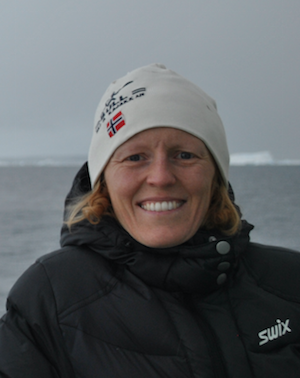Five new research projects to scientists at Geophysical Institute
In the programme FRINATEK, the research counsil distributed 251 mill. NOK on 32 new research projects. Four of these are for researchers at Geophysical Institute. We also got one of five projects in the programme Polarprog.

Main content
Projects for researchers at Geophysical Institute:
FRINATEK programme
- Sources of the Norwegian winter season snow pack constrained by stable water isotopes (SNOWPACE)
The primary objective of the SNOWPACE project is to identify where the moisture sources for the Norwegian winter snow pack are located, and how variable they are. Together with his colleagues, Harald Sodemann at Geophysical Institute, will employ stable water isotope measurements to constrain atmospheric moisture transport from source to sink. This will be achieved from dedicated field sampling of evaporating sea water, water vapor from a network of stations in the North Atlantic region, and of snowfall and snow cores of the Norwegian winter snow pack, in collaboration with our partner at UiO. The new knowledge gained from SNOWPACE, distributed as an open-access data set of all measurements collected during the project, will pave the way to constrain processes and improve parameterizations in weather and climate models, and for the management of natural resources in a changing climate.
- Pathways, processes, and impacts of poleward ocean heat transport (PATHWAY)
Marius Årthun at the Geophysical Institute receives “Young research talent”-funding for the PATHWAY-project. The purpose of PATHWAY is to understand the formation and propagation of warm and cold states with the Gulf Stream’s extension toward the Arctic, their interaction with the atmosphere above, and consequent influence on and predictability of continental climate downwind.
- Unifying Perspectives on Atmosphere-Ocean Interactions during Cyclone Development (UNPACC)
In the project UNPACC Thomas Spengler at the Geophysical Institute and his colleagues will pinpoint the influence of mesoscale air-sea interactions and diabatic effects on the genesis and intensification of extratropical cyclones with the goal of advancing our understanding of the mechanisms leading to the development of intense extratropical cyclones along strong sea surface temperature gradients and their interplay with ocean eddies.
- Marine cold air outbreaks at high-latitudes: Dynamics and imprints of mesoscale features
We hypothesise that Marine Cold Air Outbreaks (MCAOs), in conjunction with local features, such as orography, ice configuration and sea-surface temperature gradients, result in low-level convergence zones, and that severe weather originates from these low-level convergence zones. Our limited knowledge of these intense mesoscale phenomena hampers our ability to forecast severe weather events, and impedes our understanding of energy exchange between the cryosphere, atmosphere and ocean during MCAOs. To address this knowledge gap, Annick Terpstra at the Geophysical Institute and her colleagues will perform a detailed investigation and characterisation of mesoscale features associated with MCAOs.
Polarprog programme
- Topographic barriers controlling warm water inflow and Antarctic ice shelf melting (Tabaco)
Many Antarctic ice shelves are thinning rapidly as warm water enter the cavity beneath them and melt them from below. We will combine field observations with numerical modelling and laboratory experiments to study the dynamics controlling the access of warm water to the ice shelf cavities, Elin Darelius at the Geophysical Institute says . The project is a collaboration between researchers from Norway (UiB, NERSC, Aquaplan-NIVA), UK (British Antarctic Survey), Germany (AWI and University of Hamburg), France (LOCEAN) and Korea (KOPRI).
Other projects to Bjerknes researchers within FRINATEK / Polarprog:
- Tropical Temperature Reconstruction Across 0.5 million years from Cave formations (T-Trac)
Nele Meckler, Department of Earth Sciences says: With T-TRAC, we will use innovative new methods to extract past temperatures from stalagmites (cave dripstones). We will work on samples that cover the last half million years and come from the island of Borneo in the tropical West Pacific. This region hosts the warmest part of the surface ocean and is therefore an important part of the global climate system. By looking back in time, we can for example assess how different levels of atmospheric CO2 concentrations in the past affected climate in this region.
- FRActal properties of Sea Ice Leads and their impact on the Arctic physical and biological environments (FRASIL)
Pierre Rampal at the NERSC receives funding as "young research talent" with his project FRASIL. The Arctic has proven very sensitive to increased global temperatures, warming substantially faster than the rest of the globe. This has resulted in thinning and reduction in sea ice cover leading to a new dynamical regime in which sea ice fracturing and ridging are more frequent. The fractal properties of the ice cover and its extreme variability strongly influence the atmosphere-ocean interactions and the dynamics of the Arctic marine ecosystems. These interactions and their influence on climate are actively debated, although the supporting model premises are presently weak. FRASIL will enable a new perspective on the changes endured by the Arctic and their consequences for marine life.
- Ultra-High-Resolution Marine Records from the Subarctic Atlantic (ULTRAMAR) Martin Miles, Uni Research Climate
Past behaviour of the Southern Ocean`s atmosphere and cryosphere Jostein Bakke, Department of Earth Sciences
Read more on Bjerknes Centre for Climate Research's web pages.



